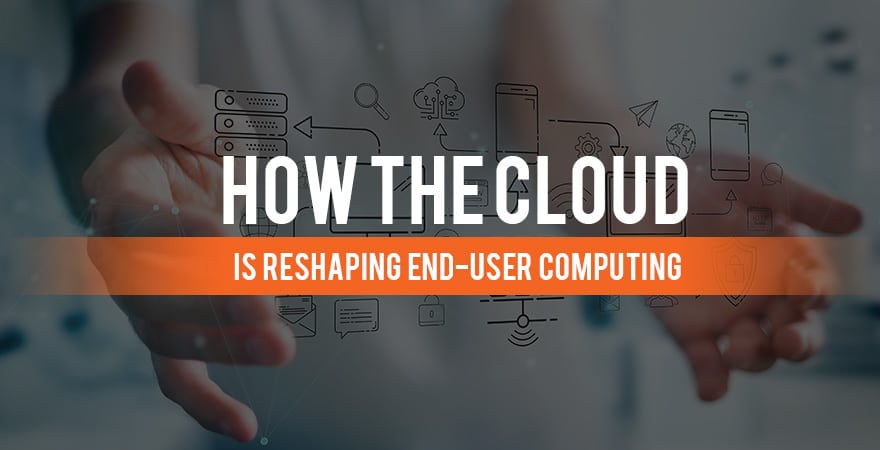How the Cloud is Reshaping End-User Computing
The foremost concept we associate with the cloud is efficiency. When we talk of efficiency, our main focus is on the organizational spectrum. Cloud Solutions definitely bring financial and operational benefits to organizations. This notion is further supported by the countless organizations embracing the cloud with open arms.

However, a generally ignored or less highlighted area is how different cloud solutions influence the end user experience. After all, the end user is a key component of any Cloud Infrastructure and its overall success depends on adding some value at the user level as well.
In the latest cloud solutions, Employee Experience (EX) is gaining center stage. A positive EX has been directly linked with higher motivation and productivity levels. Moreover, when employees see that an organization is going through the hassle of migrating to the cloud, they are likely to be curious about what’s in it for them.
The Phasing Out VDI
Virtual Desktop Infrastructure (VDI) is a relatively fading cloud solution. In this deployment, the IT infrastructure is housed within the organization. The company’s IT staff is tasked with the maintenance and troubleshooting of the network.
Rise of Cloud Desktops
Cloud desktops are quickly emerging as a strong alternative to VDI infrastructure. In this deployment, the hardware is maintained and managed by a Cloud Service Provider (CSP). This takes all the fuss of maintaining an elaborate IT hardware out of the equation and organizations can enjoy cost savings.
Cloud and End-User Experience
Regardless of the type of implementation, any cloud solution is bound to add a certain degree of flexibility and improve the employee experience. The level of ease will depend on the type of infrastructure though. Let’s discuss some of the key ways cloud solutions are reshaping user experience.
Employee Retention
Cloud Solutions in general and Cloud Desktops in particular are increasing the employee retention rates for organizations. Companies can extend a much more flexible work schedule to employees such as remote work or floating working hours.
An employee can easily access the cloud and execute all the tasks from the comfort of home or any location other than the employer’s premises. This ensures that employees remain productive even if they are incapacitated to physically show up for work.
Workforce Continuity
The smooth flow of business operations is at times disrupted by events beyond the control of the organization. Such disruptions are at times acts of nature or man-made but nonetheless, can affect organizational efficiency. Common examples of disruptive events are floods, strikes and storms etc.
In most cases, employees may not be able to come up to the work premises but still remain productive by leveraging the cloud. In this way, cloud solutions have greatly increased the efficiency of the workforce.
Scalability
Cloud Solutions make it much economical and quick for organizations to scale their operations up or down. The scaling of cloud solutions does not constitute any capital expenditures and only result in operational costs. As an entity scales up its cloud solution, it will just pay an incremental usage fee.
This instant and quick scalability has enabled organizations to adjust their workforce for variable or seasonal trends. For instance, the demand for tax consultants would really spike towards the end of a fiscal year. So a tax consultancy firm can easily engage additional tax experts for this seasonal demand.
Freelance or Project Oriented Workforce
With efficient and customized cloud solutions, the trend of hiring freelance experts is on the rise. Similarly, project oriented job offerings are getting more common. What this means for end users is that they may not now be permanent employees of an organization.
Customized Solutions
Another great news for end users of the cloud is that solutions are becoming more and more customized these days. To capture and retain market share, Cloud Service Providers (CSPs) are going the extra mile to customize their cloud offering for specific tasks.
An example can be that of an architect who needs high powered GPUs to execute modelling and testing of the designs. So, CSPs like dinCloud are offering access to GPU enabled workstations even in their base offering. With more players entering the Cloud Services industry, the bargaining power of the end user is increasing.
Multi Device Access
Today’s cloud user wants to access the data and applications from multiple devices. These devices generally include smartphone, tablet, laptop or PC. Cloud Service Providers now offer multi device access to their users so that work can be performed from any platform.
Operating System Flexibility
Multi OS access in fact stems from multi device access. A user’s smartphone may be running Apple’s iOS while the tablet may be running Windows OS. Today’s cloud solutions liberate the user from worrying about which operating system the device is running.
Conclusion
We can easily say that user experience is gaining center stage in cloud solutions. Today’s cloud solutions are geared towards delivering a flexible and superior experience to the end user.
From the perspective of Cloud Service Providers, it is imperative that customized solutions are offered that are tailored to the needs of a specific niche.
This is all for now, if you want to ask anything please Contact Us and our team will get back to you soon. Also, you can visit our Blog Section and News Section where you will find latest happenings related to Cloud Technology.


